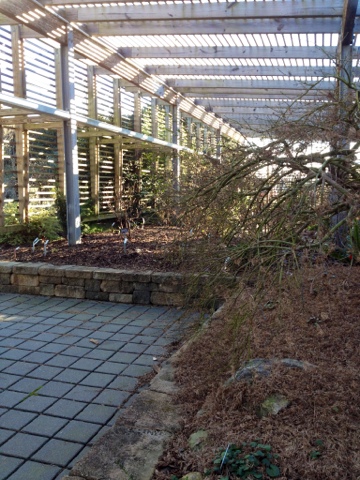Homeowners with busy lives ask me all the time for 'Low Maintenance' gardens. I am now learning through my own gardening experience in a woodland that I have naturally and unknowingly shifted my thinking to 'Managing' my garden not merely maintaining. The plant communities have become dynamic in their ability to maintain themselves. I have put together a lovely natural looking woodland garden where plants mingle and propagate on their own with little assistance from me. I have allowed the plants I have added, in essence, 'to find their own way'. Now, my job is as editor, in a design sense, to keep the garden as I would wish it to look with texture, flow and punctuation in the right places.
Ferns have found a home near the foundation in the front garden.
Gardening this way is so much more relaxed. I allow the leaves to stay where they fall (except on paths that I have chosen to mulch with wood chips.) The leaves are the woodlands natural mulch and food for the canopy tree roots and also happen to feed the perennials under them as well.
In winter the native fern Woodwardia virginica goes dormant but is circled by evergreen Fatshedera and Holly Fern.
A couple of years ago this concept of a viable 'Plant Community' growing in my gardens was reinforced to me after watching a program on plant collecting in the Balkans by Tony Avent of Plant Delights Nursery in Raleigh, NC.
His description of plants growing naturally at a woodland edge in Slovenia was very close to the same group of plants that I had unknowingly experimented with and implemented in one portion of my gardens. It was as if a thunderbolt of understanding had struck me sitting in the audience that evening. The plants that thrive together in my case with little intervention from me are: Bracken Fern, Helleborus orientalis, Epimediums, Carex species, Camassia, Rohdea, Solomon Seal and Arum italicum with a matrix base of Violas and Vinca minor. This is a mix of plants from various parts of the world that have found common growing conditions and are happily living together in a plant community that is self sustaining.
Carex and Helleborus nestling together
The term 'community' means "a group of people living in the same place or having a particular characteristic in common". This meaning does apply to plants as well.
In fact, the now considered wild places left in the world are populated with plants that live and survive together in growing conditions that make them thrive where they are. After all, plants aren't able to walk around and move to another place on their own.
PS.
This blog was inspired by a book that Helen Yoest of 'Gardening With Confidence' recently introduced to me.
'Planting in a Post-Wild World ' by:
Thomas Rainer and Claudia West.
Check out the book and Helen's Blog if you have a moment.























